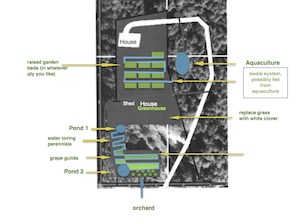Growing healthy plants requires 2 things …. good soil and lots of water. So once our future building site was cleared and rough trails and roadways laid out, we hired an amazing permaculturalist named Kim Chi to help us set out a plan for cultivating our property.
Farming on sloped property like ours does pose some challenges but also has a lot of benefits. The most critical benefit we have on sloped property is the use of gravity to help nurture our gardens, which requires less active watering, allowing us to spend more time creating plants versus caring for them. In order to do this, we had to learn and manage the “hydrology” of our property.
Hydrology is the scientific study of the movement, distribution, and quality of water on Earth (or our property in this case), including the water cycle, water resources and environmental watershed sustainability.
For us, we wanted to harness and manage the natural water sources we had available to us on the property, instead of using well water and standard irrigation, so I set out to strategically place 300 or so feet of “service pipes” to control the water movement into 3 ponds that I dug on site. A larger upper pond that collects most of the ground water coming onto our property, a second collecting pond that is at the top of our lower swale garden area and a third lower pond to collect the runoff of water that did not get used by the gardens. All of these ponds are fed by natural ground water sources as well as natural rain water run off from all of the roof surfaces on the property.
So essentially, when it rains, water from the roof comes into the downspouts and, at our main house, is first collected in 2 rainwater collection tanks. One tank is roughly 6000 liters and buried under ground, while the other surface tank is 2500 liters. Once those tanks are full, the remainder of the water is carried underground to the upper pond. I also created an infinite pond from a natural spring that was uncovered during the excavation of the building site. I turned this small spring into a 4th large pond at the head of our vegetable gardens to help with watering in the dead of summer. It also has a waterfall … which makes it extra cool.
Once we had the water in place we set out to start gardening! Or at least set up the plants that will take years to start producing food, like blueberries, apples, cherries, plums, grapes and figs. Most of these plants were put into swale gardens and covered with home-made wood chips to prevent or reduce weeds and more importantly reduce evaporation.
Swale gardens allow water to travel down the swales (or ditches) between the rows of plants and drain water into the garden mounds between the swales. In my opinion, for large surface gardening this is the only way to go! We use gravity to water our gardens by allowing water seep into the surrounding soil and feed the plants, while the wood chips prevent weeds and reduce water loss. Easy as that! More on permaculture coming up ….
